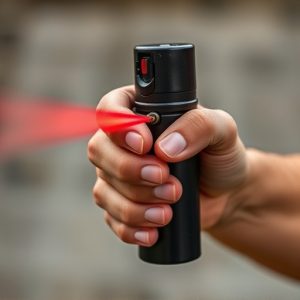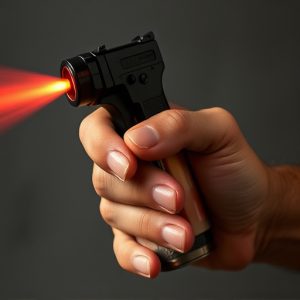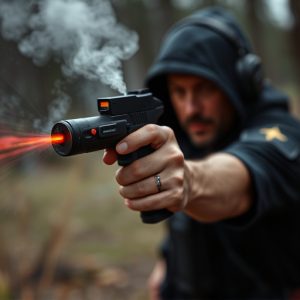Pepper Spray Safety: Storage, Carrying, & Legal Responsibilities
The optimal storage temperature for pepper spray is 50°F to 80°F (10°C to 27°C) to p…….
The optimal storage temperature for pepper spray is 50°F to 80°F (10°C to 27°C) to preserve its effectiveness, with ideal conditions at 70°F (21°C). Store it away from direct sunlight and freezing, keeping humidity below 60%. Maintain regular functionality checks, keep out of reach of children, and familiarize yourself with local laws regarding pepper spray carry. The best storage temperature is between 50°F and 70°F (10°C to 21°C), ensuring reliability by checking expiration dates regularly.
“Uncover the power of pepper spray as a personal defense tool with our comprehensive guide. From understanding its chemical makeup, which temporarily incapacitates assailants, to mastering safe storage techniques—including the optimal best storage temperature for pepper spray—this article equips you. Learn about responsible carrying practices and legal implications, ensuring effective self-defense without unintended consequences. Discover key strategies to enhance your safety and peace of mind.”
- Understanding Pepper Spray's Chemical Composition and Effects
- Optimal Storage Conditions for Effective Pepper Spray
- Safety Measures and Best Practices for Carrying Pepper Spray
- Legal Considerations and Responsibilities When Using Pepper Spray for Self-Defense
Understanding Pepper Spray's Chemical Composition and Effects
Pepper spray, a popular self-defense weapon, is designed to incapacitate an attacker temporarily through irritant chemicals. Its primary active ingredient is capsaicin, the same compound that gives chili peppers their heat. This chemical triggers a burning sensation in the eyes and nose, leading to temporary blindness and difficulty breathing. Understanding pepper spray’s composition is crucial for users to ensure safety and effectiveness.
Proper storage is essential to maintain the integrity of pepper spray. The best storage temperature for these devices typically ranges between 50°F and 80°F (10°C to 27°C). Extreme temperatures can degrade the active ingredients, reducing the spray’s potency. Users should avoid storing them in direct sunlight or freezing conditions, as this can accelerate chemical breakdown. Additionally, keeping pepper sprays out of reach of children and pets is vital for safety.
Optimal Storage Conditions for Effective Pepper Spray
Maintaining proper storage conditions is crucial for ensuring that your pepper spray remains effective and potent. The best storage temperature for pepper spray is consistently cool, dry, and dark—ideally between 50°F to 72°F (10°C to 22°C) with humidity levels below 60%. Extreme temperatures and moisture can degrade the active ingredients in pepper spray, reducing its impact when needed.
Avoid storing pepper spray in direct sunlight or near heat sources such as ovens or radiators. High temperatures can accelerate the chemical reactions that break down capsaicin, the main ingredient responsible for the sting and pain associated with pepper spray. Similarly, excessive humidity can cause the spray to become thick and less dispersible, reducing its effectiveness. Storing pepper spray in a sealed, airtight container within these optimal conditions will maximize its shelf life and ensure it’s ready when you need it most.
Safety Measures and Best Practices for Carrying Pepper Spray
When carrying pepper spray as a self-defense weapon, safety measures and best practices are paramount to ensure its effectiveness and your well-being. Always store your pepper spray in an accessible yet secure location, maintaining a best storage temperature of around 70°F (21°C) and avoiding direct sunlight or extreme heat. Keep it out of reach of children and others who might misuse it. Familiarize yourself with local laws regarding the carrying of pepper spray, as regulations vary by region.
Best practices dictate that you carry pepper spray in an easily reachable pouch or holster, close to your body for quick deployment. Ensure regular maintenance, checking the expiration date and functionality, as pepper spray can lose its potency over time. Keep it charged if it’s a rechargeable model, and store non-rechargeables in a cool, dry place to maximize their lifespan. Regularly review de-escalation techniques and self-defense strategies so that you’re prepared for any situation.
Legal Considerations and Responsibilities When Using Pepper Spray for Self-Defense
When considering pepper spray as a self-defense tool, it’s crucial to understand the legal landscape surrounding its use. Each jurisdiction has specific laws and regulations dictating when and how pepper spray can be employed legally. Using pepper spray for self-defense may be permissible in certain situations, such as during an attack or to deter imminent harm. However, exceeding reasonable force or using it in unauthorized areas can lead to serious legal repercussions. It’s essential to familiarize yourself with local laws and only deploy pepper spray when absolutely necessary.
Proper storage is another critical aspect of responsible pepper spray ownership. The best storage temperature for pepper spray is typically between 50°F and 70°F (10°C to 21°C). Extreme temperatures can compromise the integrity of the spray, affecting its effectiveness and shelf life. Keep your pepper spray out of direct sunlight and in a secure, child-proof location. Regularly check expiration dates and ensure the spray is in working order to guarantee its reliability when needed for self-defense.
Pepper spray can be an effective self-defense tool when used responsibly. To ensure its efficacy, it’s crucial to understand its composition, store it at the optimal best storage temperature (typically below 70°F or 21°C), and follow safety practices like secure carrying and proper deployment techniques. Additionally, familiarity with local laws and responsibilities is essential before considering pepper spray as a self-defense option. By adhering to these guidelines, individuals can maximize its potential while minimizing risks associated with this potent chemical agent.


